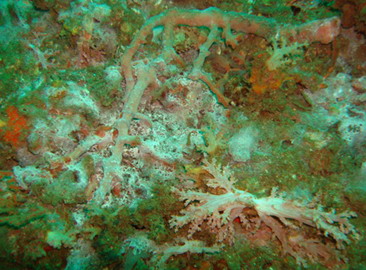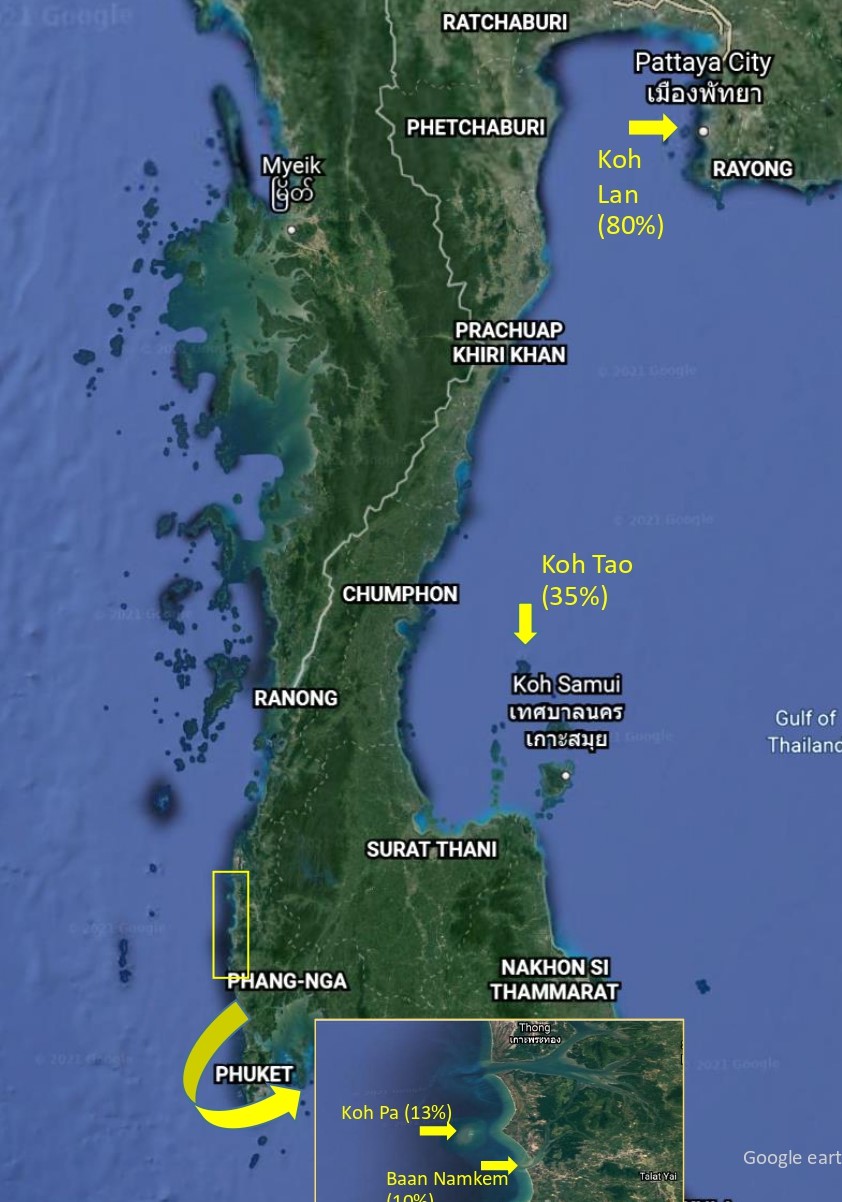Reef Anomaly at Hin Muang/Hin Daeng in Early 2007
In early 2007, a mass die-off was observed on many reefs around Krabi, Trang, and Satun provinces. This large scale die-off created a stir in the diving community. Many dive operators from these provinces reported that the water temperature during this period was abnormally low, around 23 to 24 degrees Celsius. The normal temperature for these reefs in the dry season is 28 to 29 degrees Celsius. The operators also described brown plumes in the water concurrent with the decreased temperatures. Fish, invertebrates, soft coral, etc. were observed dead, especially at Hin Muang. Mu Koh Ha reef was one of the most affected areas. The Phuket Marine Biological Center (PMBC) received samples of dead organisms from dive operators, but after an investigation of the samples, were unable to pinpoint the cause of death. An on-site investigation was conducted 6 April 2007. Water was sampled over a 24 hour period and water temperatures were recorded at the low of 23 to 24 degrees Celsius at 30 meters. Moreover, dissolved oxygen levels were also very low, ranging from 1.5 to 2 mg/L. This lack of oxygen seems to be the most probable cause for the mass die-off observed at Hin Muang. The question remains, why would an offshore island have such a low level of dissolved oxygen? The cold temperatures seem to indicate an upwelling event in that area. Normally, the mass of water from the deep sea has low temperature and low oxygen levels. When such a mass of water surfaces, it will introduce nutrients into the shallow waters. The nutrients are critical to plankton growth, and this increase in nutrients from such an upwelling event may have stimulated a large phytoplankton bloom at the offshore island. What then caused the upwelling event? Researchers at PMBC have investigated upwelling and have found that the upwelling is due to internal waves that move towards the Andaman Sea of Thailand. In early 2007, the internal waves were observed near surface. Such waves will arrive at the continental shelf at a depth of around 100m. The wave will then distribute cold bottom water to the coastal area. This phenomenon can be quite intense, as in the early 2007 event. It may be related to a large scale change in the oceanographic system. Researchers noted that in the end of 2006 the phenomenon of the Indian Ocean Dipole (IOD) was observed. The sea level in the western Indian Ocean was higher than in the east, around Thailand. This situation may be related to the Pacific El Nino Southern Oscillation (ENSO). Previous ENSO events were recorded in late 1994/early 1995 and late 1997/early 1998. The sea-level depression was particularly strong during the 1997/1998 event. Many corals in the Andaman sea died, especially on the reef flat, most likely as a result of the increased sunlight penetration due to the low tides. When water is abnormally depressed in such a fashion, the thermocline rises towards the surface. There is then an increased potential for cold water to reach the reefs. If the dissolved oxygen is not too low, marine life can survive the temperature change. In contrast, if the dissolved oxygen is low, marine life cannot tolerate it and dies. Remarkably, in 1998, the strong El Nino event resulted in high water temperatures and coral bleaching worldwide. However, in the Andaman Sea, during the same event, the water was cold. This is most likely connected to the Indian Ocean Dipole. When water in the Andman Sea is cold, the bleaching events are not so widely observed. It appears that the Indian Ocean Dipole has two primary effects. It keeps water temperatures low, resulting in minor bleaching during ENSO events. However, the increased upwelling may result in low dissolved oxygen levels, resulting in the mass die off of marine life. (Note: The author is primarily a biologist. Oceanographic information presented in this article was obtained from fellow colleagues. If there are any mistakes, please feel free to comment.)



Photo by Christian Mietz










